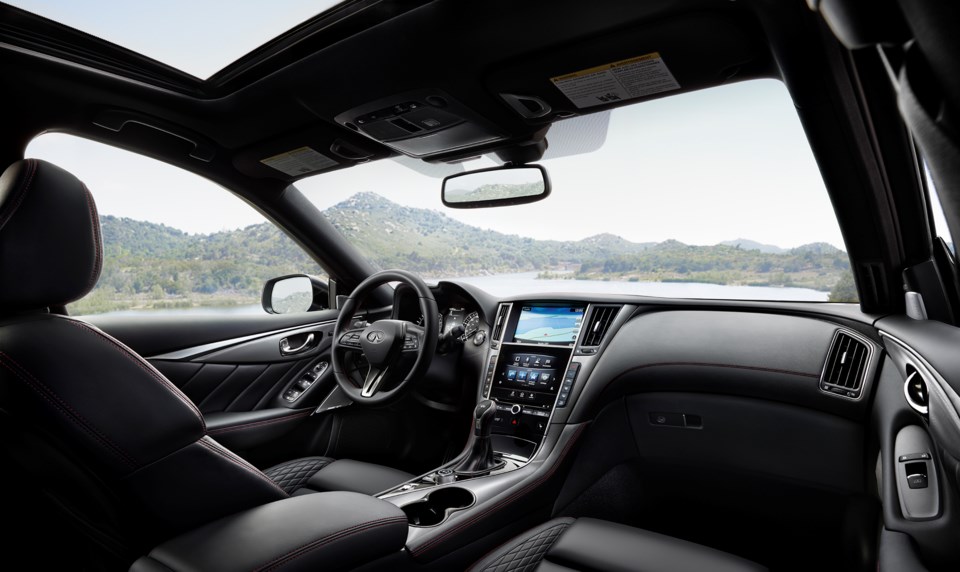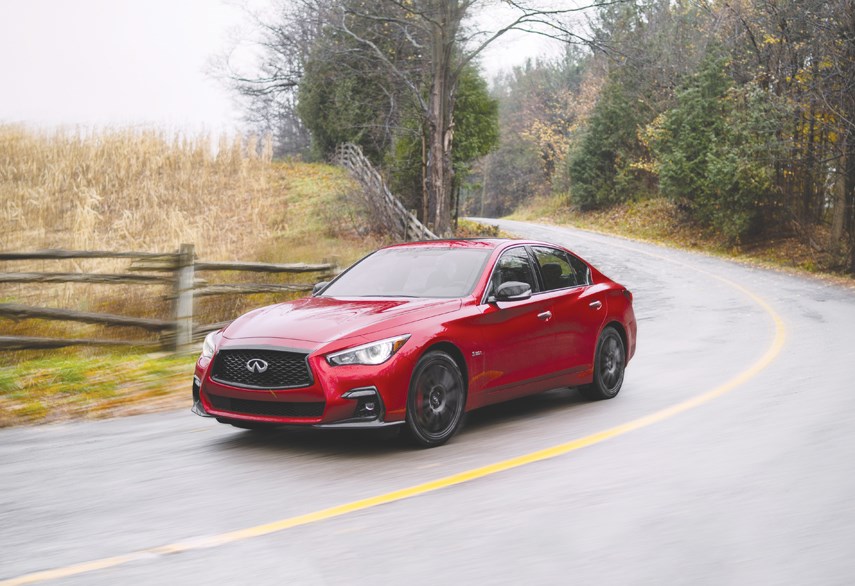It’s got to be tough being the BMW 3 Series, and having every other luxury manufacturer out there painting a target on your back.
On the other hand, it’s perhaps even harder to be one of the sport sedans that want to steal the 3er’s crown.
The problem is that BMW got there first, and has secured the high ground. They’ve got the brand cachet, the legacy of motorsport success championed by the M3, and an R&D budget that’s nearly big enough to send a car into space to go do burnouts on the moon.
Thus the Infiniti Q50 finds itself, after nearly two decades, still trying to catch up to its Bavarian nemesis. If Lexus took aim at Mercedes-Benz, then Infiniti was always supposed to be the Japanese BMW, and you can’t be a Japanese BMW without a proper sports sedan.
The Q50’s predecessors, the G35 and G37, made their argument by taking the roots of Nissan’s Z sports car and wrapping them in a more luxurious trim. It was a solid recipe, and won the brand many fans.
But the Q50 has its work cut out for it, not least because of a brand-wide naming change that had many Infiniti aficionados scratching their head. This week, it’s the Q50 signature edition that spurs the question, why would you buy one of these instead of a BMW? Let’s take a look.
Design
At first blush, things look pretty good. While other Japanese marques – ahem, Lexus – seem to be locked into an ever-bigger grille contest, Infiniti’s design language is well sorted out.
The Q50’s overall proportions won’t raise eyebrows, and its signature details are organic rather than forced. There’s a bit of a unique flair on the rear window trim, a handsome and not overwrought front corporate grille, and strong lines accenting the hood.
Infiniti’s mainstay sedan was updated last year with some tweaks to the front and rear bumpers, reworked headlights and taillights, and a few other improvements including new wheel styles. Overall the Q50 still looks fresh and garnered the odd inquisitive glance from passers-by when parked at a curb.
This being the Signature edition, a set of bright 19-inch alloys filled out the wheel wells to give a bit more sporty presence. Above this, the I-Line gets blacked-out wheels and some additional carbon-fibre exterior tweaks to go with its more-powerful engine option.
Environment
The Q50’s interior hasn’t quite aged as well as its exterior. All the comforts are here, including excellent front legroom, but the styling is busy rather than cohesive.

Then there’s the infotainment packaging in the central dash, which is beginning to look a bit dated. A little practice brings some familiarity to the two-screen system, but it’s not the most intuitive. It’s also behind the times compared to the larger, sharper displays used by the competition.
For such a relatively large car, the rear seats don’t offer quite as much space as you’d expect. And, overall, the Q50 doesn’t surprise with razor-sharp fit and finish the way a Lexus product does. In some of the controls, you can clearly feel those Nissan roots.
However, equipment levels are comprehensive, and there’s a lot of value here. The seats, as mentioned, are very comfortable, and the driving position is excellent, with good visibility. A new model will have to step up its game here, but the current one is acceptable when you factor in some of the Q50’s strengths.
Performance
Power is one of those strengths. In other markets, a 2.0-litre turbocharged four-cylinder is still the base engine, but the Canadian market starts out of the gate with a 3.0-litre twin-turbocharged V-6.
There are two power levels available, 300 horsepower and 295 foot-pounds of torque, or the higher 400 h.p. Red Sport trim. The Signature version comes with the former.
With a seven-speed automatic transmission to handle shifting duties, the Q50’s driveline is impeccably polished and eager. Naturally, the 400 h.p. variant looks like the one you want on paper, but the 300 h.p. base engine is easily powerful enough. Power comes on in a satisfying surge, and the seven-speed auto is well-programmed, with imperceptible shifts.
All-wheel drive is also a standard feature here, giving the Canadian buyer essentially everything they want in a sport sedan right out of the gate. The only thing lacking is something that used to make Infiniti a true alternative to BMW.
The Q50 is a sporty sedan rather than a sport sedan. It’s more confident and capable than a C-Class Mercedes, but the chassis is more a highway cruiser than a corner carver. The light steering has little feedback, and despite the effortless performance of the engine, the Q50 doesn’t have you dreaming of backroads on your commute.
To my mind, that’s not necessarily a bad thing. If the old Infiniti copied BMW’s playbook a little too closely, this one feels like they’re trying to listen to their customers more closely. The Q50 is very comfortable and stable at highway speeds, has excellent passing power, and shrugs off sweeping corners with ease.
Rather than being a backroad dancing companion, it’s a proper grand tourer. And, at the same time, it’s a bit more interesting to drive than some of the more luxury-oriented offerings out there.
With its driving characteristics, the Q50 really does offer a compelling argument to consider it over a German product. And then it doubles down with its ace in the hole.
Features
Base models of the Q50 start at $44,995 with all-wheel drive and twin-turbocharging, and the Signature edition adds just $1,500 for special trim, 19-inch alloys, and sport seats.
Heated leather seats with adjustable thigh support, satellite navigation, and even keys that remember your preferred climate and audio settings are all here. The Q50’s final Signature move is to show excellent value when compared to the German brands and their often expensive options.
Fuel economy figures are middle-of-the-road and premium fuel is required. Official figures are 12.4 litres/100 kilometres in the city and 8.7 l/100 km on the highway. The Q50 achieved mixed-mileage results that weren’t far off the official numbers.
Green light
Sharp looks; excellent drivetrain; solid value.
Stop sign
Dated interior; non-intuitive infotainment; numb steering.
The checkered flag
A proper alternative to the obvious luxury sedan choices, and well-priced to boot.
Competitor
BMW 3 Series: Well, obviously. Long the benchmark for sport sedans, the BMW 3 Series is newly refreshed this year, and sportier than ever.
The six-cylinder version isn’t quite out yet, but it’s bound to give the Q50’s 400 h.p. variants a run for their money. In the meantime, the turbocharged four-cylinder version is up to the task on peak power, and also returns better fuel economy. Further, it’s not out of place on a track.
However, you will have to pay for all this performance, and BMW’s interiors can be a little austere. The latest and greatest might be the most obvious choice, but not always the best.



